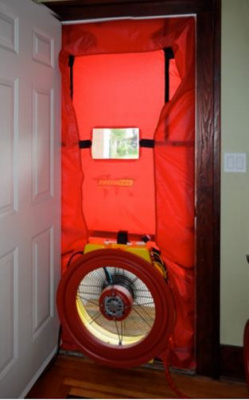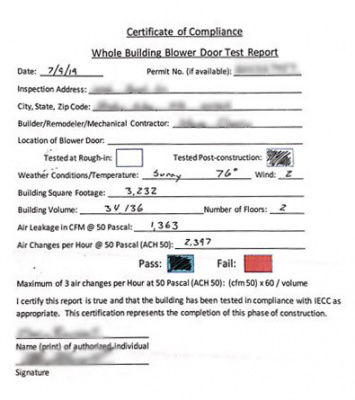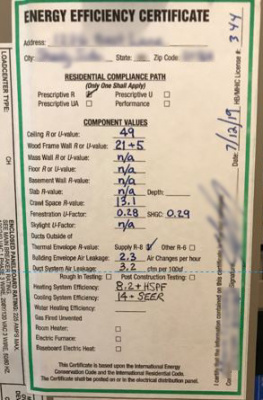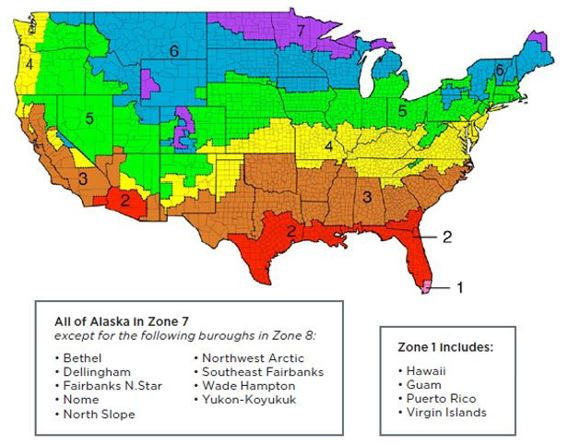Three previous articles in this series addressed the significance of air leakage control, various air barrier materials and methods, and installation and inspection practices. In this fourth and final article, we address blower door air-leakage testing.
Blower Doors and Code Requirements
At the most basic level, a blower door air-leakage test uses a door with a fan (blower) and instrumentation to monitor air flow and pressurization (or depressurization) of the building at standardized test conditions (see Figure 1). Based on the geometry of the building, the air flow rate is then converted to an ACH value (i.e., air changes per hour for the enclosed, conditioned volume of the building at a specified pressure differential) or CFM/ft2 value (cubic feet of air leakage per minute per square foot of exterior enclosure surface area).
Figure 1: Photo of a Blower Door

Typically, these tests and the required calculations are performed by a blower door or envelope or energy rating consultant. Additional information on air-barriers, installation, and testing can be found at Resources for Air Barriers.
Blower door tests have become commonplace with the adoption of a requirement for air-leakage tests for one- and two-family dwellings in 2012 and later editions of the IECC residential energy code (see Table 1 and Figure 2). While air-leakage testing remains optional in the IECC commercial energy code provisions (even though the code does include a maximum air leakage target), air-leakage tests are increasingly used on a project-by-project basis to verify and deliver properly performing commercial buildings. Thus, air-leakage testing as required or used as good practice is being driven by a growing appreciation for the significance of air leakage control.
Table 1: 2009 vs. 2012/2015/2018 IECC - Residential
| Climate Zone | 2009 IECC | 2012/2015/2018 IECC |
| 1-2 | < 7 ACH | ≤ 5 ACH @ 50 pascals |
| 3-8 | < 7 ACH @ 50 pascals | ≤ 3 ACH @ 50 pascals |
| Air sealing list & visual inspection | Yes | Yes |
| Blower Door Test | Not required | Required |
ACH = air changes per hour; a measure of building air tightness.
Figure 2: U.S. Climate Zones
Figure 3: Example Blower Door Test Report from Consultant

For those concerned with delivering a code-compliant and energy efficient building, the blower door air-leakage test is your friend. The blower-door test complements the application of any type of air barrier material and method. It also complements the effort to follow prescriptive practices for air barrier installation and inspection by helping to detect and correct missed leakage paths. This is typically done by use of tools like “smoke sticks” or even infrared cameras while the building is pressurized or depressurized by the blower door. It provides assurance that the target air leakage rates are met and this will also provide assurance that the building will perform with energy savings, comfort, and moisture-control performance as intended by the code or by design.
In addition, if HVAC equipment are properly sized, then ensuring that air leakage rates are consistent with the assumed building air-leakage rate is very important to the performance of the HVAC system. Hence, there are many good reasons to perform a blower door test to demonstrate code compliance.
Example Blower Door Results
Now that we have established what a blower door test is, how it is used, and its many benefits, it is time to put it into practice and look at some results. Figure 3 is an image of an actual blower door test consultant’s report to the builder. The test report indicates an ACH of 2.397 (rounded to 2.4) which is comfortably below the maximum allowed 3 ACH for the subject house in Climate Zone 4 (see Table 1 and Figure 2).
Figure 4: Example “Energy Efficiency Certificate”

To readily convey this information to the building inspector and the home owner (including future home buyers), the result also is included on a code-required “energy efficiency certificate” placed on the home’s electric panel (Figure 4). This certificate is extremely important to the value of an energy efficient home as the information on this certificate is not easily seen or otherwise known. Clearly, the blower door is a valuable friend of the builder, inspector, and building owners or future buyers.
For more information on air-barriers and air-leakage control, refer to the Air Barrier Topical Library on Continuousinsulation.org.
- Air Barriers: Small Details Make Big Difference
- How Exterior Walls Breathe
- Air-Sealing the Lid: A High Performance Solution
- What Caused the Air Barrier Industry to Develop?
- What’s the Big Deal with Air Leakage?
- How To: Air-Sealing Simplified
- Retrofit Concepts Improve Energy Efficiency
- Why Air Sealing a Garage Wall is Important
- Choosing the Right Air Barrier Material for Your Project
For additional information, please review the following articles and videos:
Articles
- Creating the ‘Perfect Wall’: Simplifying Water Vapor Retarder Requirements to Control Moisture
- Perfect Walls Are Perfect, and Hybrid Walls Perfectly Good
- Energy Code Math Lesson: Why an R-25 Wall is Not Equal to a R-20+5ci
- Continuous Insulation Solves Energy Code Math Problem
- Presentation: What Is the Value of Continuous Insulation?
- What Does Building Envelope System Integration Mean?
- POV Photos – Benchmarking OSB/Foam Sheathing Moisture Performance
- How Do WRBs & Drying Concepts Work in Exterior Walls?
- Drying a Wall to the Interior and Exterior, Vapor Barrier Placement
- JM’s Babineau Looks at Hybrid Insulation Approaches
- Why Energy Efficiency is the Best Investment
Videos
- Fear Building Envelopes No More with This Website & Videos
- Video: Thermodynamics Simplified Heat Flows from Warm to Cold
- Video: Moisture Flow Drives Water Induced Problems
- Video: How the 'Perfect Wall' Solves Environmental Diversity
- Video: How Important Is Your WRB?
- Video: A Reliably Perfect Wall Anywhere
- Video: The Best Wall We Know How to Make
- Video: How to (Not) Ruin a Perfectly Good Wall
- Video: Tar Paper and Continuous Insulation? No Problem!
- Video: Do CI and WRBs Go Together?
- Video: Assess Your 'Perfect Wall' Using Control Layers
